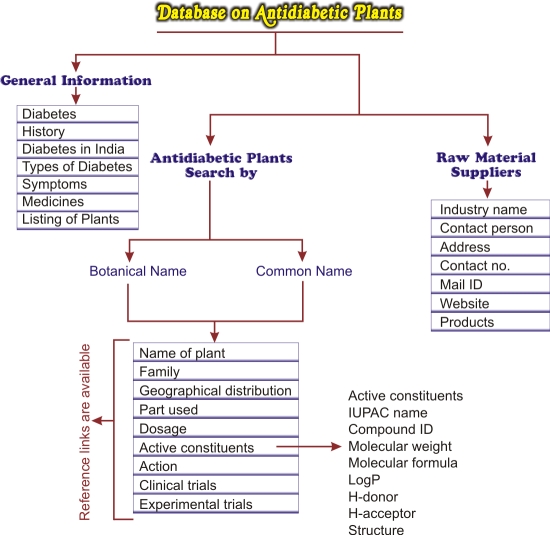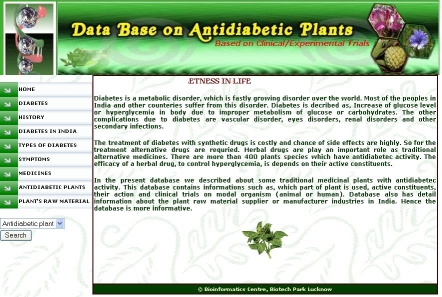Abstract
A number of plants have been described in Ayurveda and other traditional medicine for the management of diabetes. However, information about them is not easily available. Active constituents of any medicinal plant define the efficacy and safety of treatment to control hyperglycemia. We describe the database to maintain the record of medicinal plants having anti-hyperglycemic or anti-diabetic activity. The database contains information such as plant name, its geographical distribution, useful plant part, known dosage, active constituents, mechanism of action and clinical/experimental data. The database also includes information about plant raw material suppliers or manufacturers in India. The current database includes 238 plants species and 123 Indian industries using them.
Availability
The database is freely available at http://www.biotechpark.org.in/antidia/index.html
Keywords: diabetes, medicinal plants, database, literature, anti-oxidant
Background
Diabetes is a syndrome characterized by deranged carbohydrate metabolism resulting in abnormally high blood sugar level (hyperglycemia). It is caused by hereditary, increasing age, poor diet, imperfect digestion, obesity, sedentary lifestyle, stress, drug-induced, infection in pancreas, hypertension, high serum lipid and lipoproteins, less glucose utilization and other factors. It is estimated that the diabetic patients in India will increase by 195% in the near future [1]. The treatment of diabetes with synthetic drugs is costly and chances of side effects are high. For example, long-term use of Exenetide (Byetta) [2] has lead to side effects such as nausea, vomiting, diarrhea, dizziness, headache, jittery feeling and acidity. Sulfonylureas cause abdominal upset, headache and hypersensitivity, while Metformin[3] causes diarrhea, nausea, gas, weakness, indigestion, abdominal discomfort and headache. Thiazolidinediones has side effects like, upper respiratory infections and sinusitis, headache, mild anemia, retention of fluid in the body which may lead to heart failure and muscle pain.
Ayurveda and other traditional medicinal system for the treatment of diabetes describe a number of plants used as herbal drugs. Hence, they play an important role as alternative medicine due to less side effects and low cost. The active principles present in medicinal plants have been reported to possess pancreatic beta cells regenerating, insulin releasing and fighting the problem of insulin resistance [4]. Aloe vera juice stimulates the release of insulin from the beta-cells in human, Acacia catechu wood extract enhances the regeneration of pancreatic beta cells in rabbits, Momordica charantia fruit extract enhances insulin secretion by the islets of Langerhans etc. A significant proportion of these plants have been observed to possess potent antioxidant activity, which may contribute to anti-diabetic property in streptozotocin/alloxan, induced animal model [5]. Not only in Ayurveda, but also in several other traditional systems of medicine, it is described that plants useful in diabetes also possess strong antioxidant/free-radical scavenging properties [6]. In Ayurveda, diabetes is described as ’Madhumeha‘. Ayurvedic preparations in spite of their established efficacy for the treatment of diabetes are not very popular due to lack of systematic information about the active constituent(s) for a given plant, their mechanism of action, side effects, clinical or experimental data etc. Thus, there is a need to document such information in the form of a database. Limited databases are available for anti-diabetic plants. However, information on clinical/experimental trial and supplier industries of raw materials of anti-diabetic medicinal plants are not available in such databases.Here, we describe a database containing information for anti-diabetic plants and their use. The database describes medicinal plants having anti-diabetic activity with other related information including relevant references. The database also contains detailed information about the plant raw material supplier industries in India with respective products.
Methodology
Data collection
Data of anti-diabetic plants on clinical/experimental trials were collected from literature sources such as PubMed [7], Science Direct [8], Biomed Central [9], Springerlink[10], Scirus [11], Wiley journals [12], Journals of phyto-medicine [13], Journals of Ethanopharmacology [14] and through collection of folklore medicinal usage. The information about the plant raw material suppliers or manufacturers has been collected from their websites. The database includes 203 genus and 238 species of plants having role in the treatment of diabetes and 123 plant raw material suppliers/manufacturers within India(see supplementary material).
Database design
The Database was constructed using standard HTML and JavaScript. It has a web-based, flat-file type user interface with simple global search, specific database search, keywords help and with links to references in other external databases. The schema for anti-diabetic plant database is given in Figure 1.
Figure 1.
Schema diagram representing anti diabetic plants data
Software
Microsoft Windows 95/98/2000/2003/XP operating system was used in the development. HTML was used for the creation of web pages and java script was used for the development of database front end.
Hardware
Personal computer with high-speed processor with Windows 95/98/2000/XP OS was used. We used 10.08 MB memory for running the database.
Database features
The record entry contains the following information:
name of the plant;
geographical distribution;
part of the plant investigated;
dosage;
active constituents with anti-diabetic property (active constituents also have a link which provided compound structure as well as their physical and chemical properties.);
action;
model organism (Human, dog, rabbit, rat, mice etc. and their quantity) on which the clinical /experimental studies have been done.
This web database also contains information about plant raw material supplier or manufacturer industries in India such as company name; contact person; address; contact number; E-mail ID; websites and products. These industries are the sources of plant raw material for direct use and production of herbal drug material for treatment of diabetes as well as other diseases. The database also contains current information about diabetes incidences across the world. The information about plants can be retrieved alphabetically using botanical name or common name of plant and about plant raw material supplier industries through name of the industry.
Utility
This freely available web database provides supplementary and useful information about anti-diabetic plants capable of controlling diabetes. The database also contains clinical or experimental trials data with source of plant raw material for potential use as therapeutic material. The database is also useful for the scientific community and industries for a quick and informative review on anti-diabetic plants.
Future development
We plan to further refine and update this database with links to known drugs related data in the near future.
Supplementary material
Figure 2.
A screen shot of the database “Database on anti-diabetic plants” home page with links and dropdown search window.
Acknowledgments
The support of Department of Biotechnology, Ministry of Science and Technology, Government of India, to Bioinformatics Centre at Biotech Park Lucknow is gratefully acknowledged.
Footnotes
Citation:Singhet al, Bioinformation 4(6): 263-268 (2009)
References
- 1. http://www.who.int/en/
- 2. http://www.drugs.com/byetta.html.
- 3.Bolen S, et al. Ann Intern Med. 2007;147:386–399. doi: 10.7326/0003-4819-147-6-200709180-00178. [DOI] [PubMed] [Google Scholar]
- 4.Welihinda J , et al. Acta Biol Med Ger. 1982;41:1229. [PubMed] [Google Scholar]
- 5.Grover JK, et al. J Ethnopharmacol. 2002;81:81. doi: 10.1016/s0378-8741(02)00059-4. [DOI] [PubMed] [Google Scholar]
- 6.McCune L, et al. J Ethnopharmacol. 2002;82:197. doi: 10.1016/s0378-8741(02)00180-0. [DOI] [PubMed] [Google Scholar]
- 7. http://www.ncbi.nlm.nih.gov/PubMed/
- 8. http://www.sciencedirect.com.
- 9. http://www.biomedcentral.com.
- 10. http://www.springerlink.com.
- 11. http://www.scirus.com.
- 12. http://www3.interscience.wiley.com/cgi-bin/home.
- 13. http://www.ingentaconnect.com/content/urban/211.
- 14. http://www1.elsevier.com/cdweb/journals/03788741/viewer.htm.
Associated Data
This section collects any data citations, data availability statements, or supplementary materials included in this article.




